VW Hits the Electric Car Market—Hard
Much debate always ensues when a major company brings a product to market after its competitors have already launched theirs. Does it have to be just a little bit better or must it break new ground and redefine the category? When you’re the 13th entry in a segment, how do you distinguish yourself?
Volkswagen’s answer to those marketing challenges for the e-Golf essentially comes down to the way it markets most of its cars. That is: “Hey consumer, it’s a German-engineered car you can
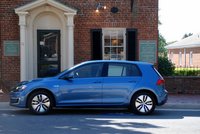
afford.” The 2014 Volkswagen e-Golf is, first of all, a VW Golf—and that’s a good thing. The Golf is an efficient hatchback that’s now in its seventh generation and has evolved into a great road machine with enough creature comforts so it doesn’t feel like a stripped-down sports machine. It’s a real car that’s fun to drive. And the electric version carries that tradition into the zero tailpipe emissions world.
It’s not surprising the Golf is as well-tuned as it is. The model going back to Rabbit days has carved out a reputation for good road-handling as well as fuel efficiency. The strut-type front suspension for the driven wheels is augmented by coil springs, telescopic dampers and an anti-roll bar. In the rear you have a multilink suspension with coil springs, telescopic dampers and an anti-roll bar. Add to that the almost 700 pounds of the 24.2 kWh Panasonic lithium-ion battery pack under the rear seat, and you’ve got a car that not only stays planted to the road, but has the ability to handle whatever curves are thrown its way. Even with the 16-inch low rolling resistance tires, the grip is impressive.
We mentioned that this is the seventh generation Golf. The model has been around for 40 years now, which would make it its ruby anniversary. Since rubies don’t necessarily look great on cars, the logical present for the e-Golf might be one of the Bosch home charger systems that VW offers along with the car. To close the loop on sustainable electricity, VW is working with SunPower to allow e-Golf customers to install a solar system to supply clean power and set up an energy storage system.allow e-Golf customers to install a solar system to supply clean power and set up an energy storage system.

Volkswagen is making its own anniversary present for e-Golf purchasers by investing $10 million into an express-charging corridor that ChargePoint has commited to build on the east and west coasts. When completed, that system will feature 100 DC fast-chargers spaced no more than 50 miles apart along major highways. VW will augment this additional fast-chargers at some dealer locations.
So that’s the evolving landscape of the electric car in 2015. Thinking back 40 years to when the Golf first appeared, the price of gasoline was 35 cents a gallon and stations were ubiquitous. Nobody other than thrifty college student who outgrew their Beetles were looking for the kind of fuel economy and utility offered by a compact hatchback. Fast forward to Clean Fleet Report testing the e-Golf; gas prices were at least six times the 1975 price and electric cars are starting to make sense, particularly as fast-charging helps make them into something other than a short commuter.
Real-World Range Anxiety
The 2014 Volkswagen e-Golf has an estimated range of 70-90 miles according to VW. We put that to a test with an 80-mile roundtrip down the coast that included a climb up and over an 1800-foot set up hills—twice. The e-Golf performed flawlessly, accelerating and holding its own on the freeways, but on the freeway and climbing the hill the range dropped precipitously. Those unfamiliar with electric cars might not realize that 90 miles of range does not necessarily mean 90 miles in the real world. Hills, freeway speeds and quick acceleration all drop that range quicker than the actual miles you may travel. The same phenomena occurs with a gasoline car, but given a typical 300-mile range for a gas-powered car, the effect is less noticeable.
In an electric that’s not the case. I had not nearly charging opportunity at the trip’s midpoint, so as headed back I climbed the hill and saw the range drop to very close to the distance I needed to travel to get home. A moment of panic set in as I calculated tow charges and potential lost time. I wondered what the Golf would do when it ran out of juice. Would it stop in the lane, or would I have the chance to pull over to the side?
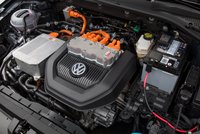
Then something amazing happened. In the same way coasting down a hill ups a gas car’s fuel economy, the effect on an electric is even more dramatic. As I zipped down the hill, my range increased and regenerative braking added even more to the electric “tank.” I breezed home with miles to spare. The range estimate of the Golf turned out to be fairly accurate, even with two hill climbs and sustained freeway driving. I experienced in that short drive what many EV drivers report as they grow more accustomed to their cars; you quickly get a sense of exactly how far you can go and you adjust your drives to fit the range and recharging opportunities.
Three Driving Modes
That trip also gave me a chance to test out the three driving modes the e-Golf offers—normal, Eco and Eco+. The latter, which of course delivers the maximum range, was my default as I tried to make sure I could stretch the electrons to complete my trip. But—and it’s a big but—it’s not the way you want to travel if you’re on the freeway. Top speed is limited to roughly 60 mph and acceleration is stifled in a move to conserve battery juice, so using it around town or when truly stressed about getting to your next charge point (as I was), is the recommended use. On the other hand, the Eco mode delivered acceptable freeway and around-town performance and the car’s ability hold its own in traffic didn’t seem to be compromised severely. Another feature of the three modes is an increasingly aggressive regen action on the brakes.
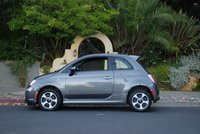
Of course, normal mode is as it implies; maybe even more than it implies, since as I’ve said the e-Golf is in most ways a true Golf. It’s a fun-to-drive, functional car that transfers the driving performance of a GTI into an electric vehicle. In many ways it resembles what Fiat has done with the 500e, where it gave Abarth-like performance to its electric model. We think this is a good thing, something that will help electric cars gain their rightful place in the automotive world.
Mentioning the 500e brings us back to the bottom line with the e-Golf. It has displaced that fun little runabout as our favorite electric car. Chalk one up for functionality. The e-Golf loses none of its four-door, four-passenger (five in a pinch) capacity while adding the option of cargo space similar to a small SUV with the rear seat folded down (52.7 cubic feet). Unlike some of the models out there, no interior space was lost in the conversion of the traditional Golf to electric mode. It may not have the style of the little Fiat, but it tries with its unique C-shaped LED running lights. All-in-all, the e-Golf may be a little late to the party, but it looks like it’s ready to get-down and boogie with the best of them.
Here’s a look at some of the nuts and bolts of the e-Golf.
Powertrain
Providing the power in the 2014 Volkswagen e-Golf is an 85 kW (115 hp) synchronous AC permanent magnet electric motor that cranks out 199 lb-ft of torque. Juice comes from the 323-volt lithium-ion battery and is delivered to the wheels through a single speed transmission. As mentioned, the power can be delivered in three driving “styles.” The normal mode allows full use of the available horsepower and torque, enabling 0-60 acceleration of just over 10 seconds and a top speed of 87 mph. In “Eco” mode, power is limited to 94 horsepower and 162 lb-ft of torque and the air conditioning and accelerator pedal have different response curves. Top speed is 72 mph and it will do 0-60 in about 13 seconds. The “Eco+” mode responds to the conservator in everyone by limiting power to 74 hp and 129 lb-ft of torque, a top speed of 56 mph and less responsive accelerator pedals and no air. Not to worry, if you find the need to truly accelerate and mash the pedal, the car will shift back to “normal” mode and deliver the needed power. Regenerative braking also has three driver-selectable modes that recapture differing amounts of braking energy. A 7.2 kW onboard charger allows charging in three possible modes—11/120-volt wall socket (in 20 hours), a 240-volt wallbox (less than four hours) or a DC fast-charger using the Combined Charging System (CCS, 30 minutes).
Pricing
Pricing on the e-Golf is fairly similar to its competition. The list price is $35,445 and typically 36-month $299 leases are available in select states (with $2,349 down). Package deals with the Bosch home-charging system are available. The level of standard equipment is fairly high, including LED headlights and DRLs, the 7.2 kW onboard charger, 16-inch aluminum-alloy wheels, a heat pump, a touchscreen navigation and infotainment system, Sirius XM Satellite Radio, a Media Device Interface (MDI) with iPod integration, Bluetooth connectivity, VW Car-Net connected services, V-tex leatherette seating surfaces, leather-wrapped multifunction steering wheel and shifter knob, heated front seats, Climatronic dual-zone automatic climate control, front and rear Park Distance Control, rearview camera and rain-sensing wipers.
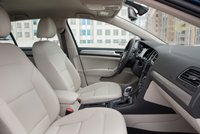
Safety
Like the gas and diesel Golfs, the e-Golf comes with a full complement of safety equipment, including six airbags and a variety of electronic and mechanical driver assistance and safety systems, such as Electronic Stability Control (ESC), four-wheel, three-channel anti-lock brakes and an Automatic Post-Collision Braking system that applies the brakes when a collision is detected by the airbag sensors.
Warranty
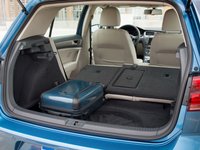
The 2014 Volkswagen e-Golf comes with a 5-year/60,000-mile powertrain limited warranty and 3-year, 36,000-mile new vehicle limited warranty. The battery’s limited warranty covers it to eight years or 100,000 miles. The car also comes with what should be a must for electric car owners—a 3-year/36,000-mile roadside assistance program and a 1-year/10,000-mile Carefree Maintenance Program that covers the car’s first scheduled maintenance at no charge.
Bottom Line
The e-Golf may be arriving late on the electric car scene, but it feels like it is worth the wait. The car delivers all of the fun of a gas/diesel Golf with no petroleum. It’s a great package and worth a look. It answers emphatically that an electric car can be virtually indistinguishable from its gas/diesel brothren, but still shine in its own merits. The 2014 Volkswagen e-Golf isn’t the first, but it’s got our vote as the best of the mainstream (i.e., affordable) electric cars.
Related stories you might enjoy:
Road Test: 2013 Fiat 500e
Top 10 Green Cars Named
Road Test: 2014 BMW i3

You don’t consider Renault with Tweezy, Zoe and Kangoo
@Leukhippe,
We’re based in the U.S. and test U.S.-available vehicles. None of the Renault vehicles are available here (which we regret greatly just because of their cool names). –ed.